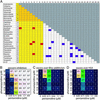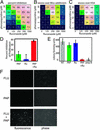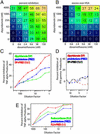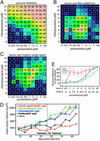Systematic discovery of multicomponent therapeutics
- PMID: 12799470
- PMCID: PMC164698
- DOI: 10.1073/pnas.1337088100
Systematic discovery of multicomponent therapeutics
Abstract
Multicomponent therapies, originating through deliberate mixing of drugs in a clinical setting, through happenstance, and through rational design, have a successful history in a number of areas of medicine, including cancer, infectious diseases, and CNS disorders. We have developed a high-throughput screening method for identifying effective combinations of therapeutic compounds. We report here that systematic screening of combinations of small molecules reveals unexpected interactions between compounds, presumably due to interactions between the pathways on which they act. Through systematic screening of approximately 120,000 different two-component combinations of reference-listed drugs, we identified potential multicomponent therapeutics, including (i) fungistatic and analgesic agents that together generate fungicidal activity in drug-resistant Candida albicans, yet do not significantly affect human cells, (ii) glucocorticoid and antiplatelet agents that together suppress the production of tumor necrosis factor-alpha in human primary peripheral blood mononu-clear cells, and (iii) antipsychotic and antiprotozoal agents that do not exhibit significant antitumor activity alone, yet together prevent the growth of tumors in mice. Systematic combination screening may ultimately be useful for exploring the connectivity of biological pathways and, when performed with reference-listed drugs, may result in the discovery of new combination drug regimens.
Figures




References
-
- Mokbel, K. & Hassanally, D. (2001) Curr. Med. Res. Opin. 17, 51-59. - PubMed
-
- Shawver, L. K., Slamon, D. & Ullrich, A. (2002) Cancer Cell 1, 117-123. - PubMed
-
- Gibbs, J. B. (2000) Science 287, 1969-1973. - PubMed
-
- Lenz, G. R., Nash, H. M. & Jindal, S. (2000) Drug Discovery Today 5, 145-156. - PubMed
-
- Druker, B. J. (2002) Trends Mol. Med. 8, S14-S18. - PubMed
MeSH terms
Substances
LinkOut - more resources
Full Text Sources
Other Literature Sources

